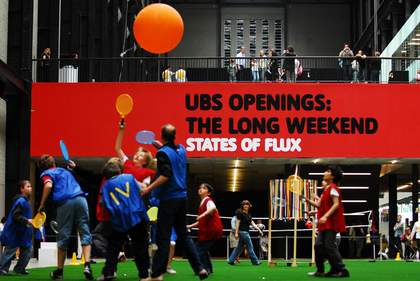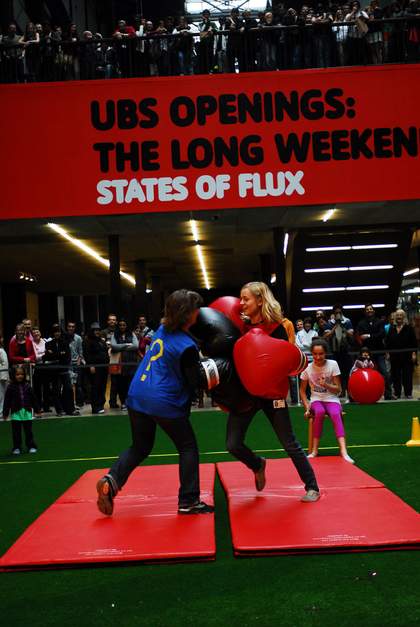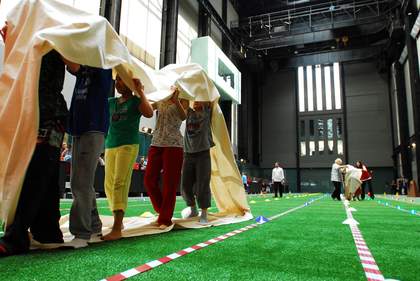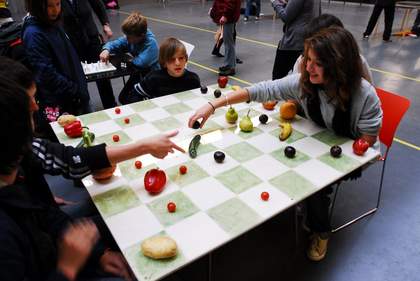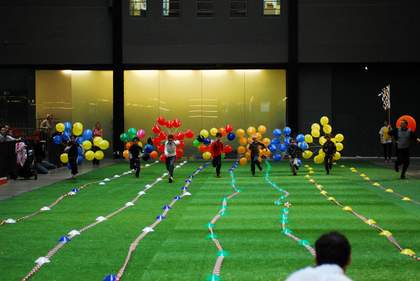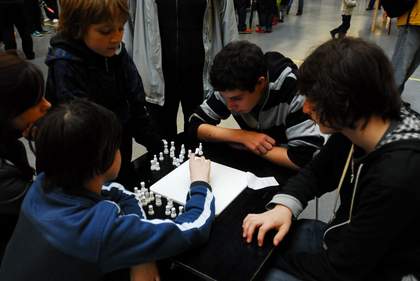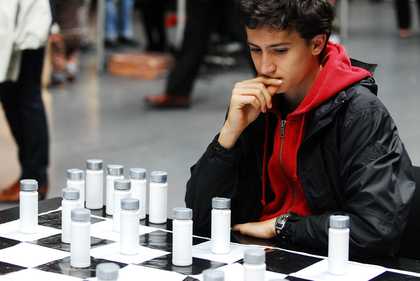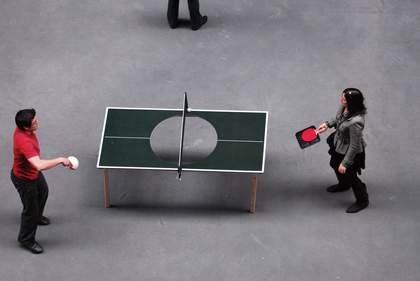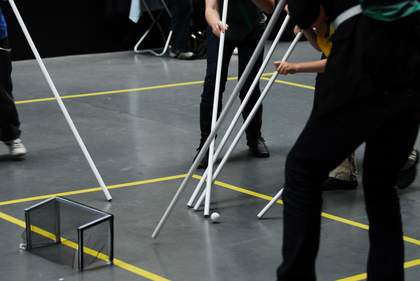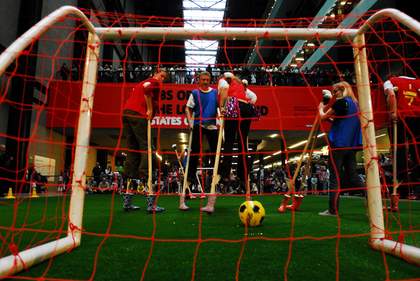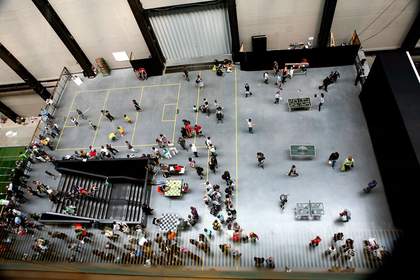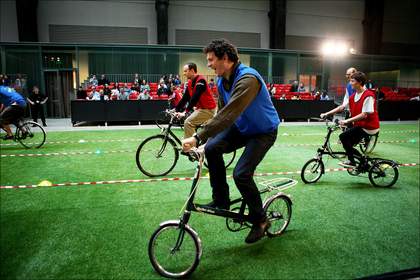Flux-Olympiad was a series of events that ran across three days of the 2008 iteration of The Long Weekend at Tate Modern. It was organised by Larry Miller, a Fluxus-influenced artist, and Tom Russotti, founder of The Institute of Aesthletics. Spread across the Turbine Hall and on the Turbine Hall bridge, Miller and Russotti created a sports field from rolls of fake grass, bordered by a winners podium and raked seating for spectators. Table-top games were set up across the space and coloured tape was used to construct courts for other sports, including badminton. This was, however, where the familiar tropes of sports and games stopped. The Flux-Olympiad saw bizarre twists alter well-known games and invented some unique examples of its own. Many of the events – some designed for single competitors and others for teams – were re-imaginings of Fluxus games, such as Larry Miller’s Vegetable Chess, and some were newly devised or adapted for the event, such as Tom Russotti’s improvised Continuous Blow Soccer.
Tate Modern’s Flux-Olympiad marked the realisation of an idea first conceived, but never fulfilled, by George Maciunas, who was a founding member of the Fluxus movement in the 1960s. Responding to the Tate’s collection display States of Flux, which included a significant amount of archival material around Fluxus, The Long Weekend, and particularly the Flux-Olympiad, explored the history of the movement through the reimagining of classic Fluxus works and its legacy for contemporary art.
Individual races took place down the length of the Turbine Hall and included the Flipper Feet Race, the Invisible Hurdle Race as well as the 200 Metre Balloon Dash. Perhaps the most subversive activity was the Slow Bicycle Race, for which competitors mounted a number of different styles of bicycle and rode as slowly as possible down the track, with the aim of being the last to finish. The accompanying commentary inverted the priorities of the usual play-by-play. Team races also took place across the track, including the Team Ski Run and the People Cluster Race. In Team Loop Race, groups of five people stood inside a large fabric loop, which had to be fed forwards, under their feet, in order for the team to progress, much like the tread on a tyre. These team races required a considerable amount of co-operation among the participants, most of whom had never met before.
A number of team sports were also taking place in the Turbine Hall and simultaneously on the bridge above, such as Stilt Soccer and Continuous Blow-Soccer, the latter of which involved advancing the ball by blowing through a long pipe. Prepared Ping-Pong challenged teams of two to compete in a game of table tennis with a specially prepared table: on one, a large hole had been cut in the middle of the table; in another it was a set of holes in different shapes; and the last featured a series of maze-like borders that caused the balls to get stuck or bounce off at unexpected angles. The available bats had also been manipulated, either by the inclusion of holes, or by their being supplemented by the attachment of sponges, muffin trays or basketballs.
Finally, three chess tables offered the chance for visitors to play variations on the game. Smell Chess was played on a larger version of the chess board, but using white-painted spice jars, indistinguishable from one another apart from smell. White Chess removed all black squares and pieces from the chess set, meaning that both players played with white pieces on an all-white board, adding the complication of having to remember which piece belonged to which player and Vegetable Chess replaced all of the traditional pieces with various fruits and vegetables.1
The Flux-Olympiad, the realisation of Maciunas’s vision for the Flux Olympiad, pulled together sport and art as two areas of culture that trade in visual spectacle and participation. Had the work been realised in the 1960s, as Maciunas envisioned, it would have been a very different event. Resolutely anti-bourgeois, Fluxus artists looked to deconstruct accepted notions of art and to challenge the museum’s role in valuing and championing high art. Instead they were interested in art that could be explored and experienced by a mass audience. Art involving participation was an exception, rather than a norm, during the 1960s, with Fluxus members frequently using self-organised festivals and events outside of the museum to bring an audience to a new, democratic way of making art, not restricted to those with a specialist education. Bringing the Flux-Olympiad to the Turbine Hall at Tate Modern offered a very different backdrop for the event and also registered the change in what kinds of activities and behaviours could be supported by the museum. At Tate Modern the audience was used to participating actively and the museum to facilitating that participation.
Acatia Finbow
November 2015

